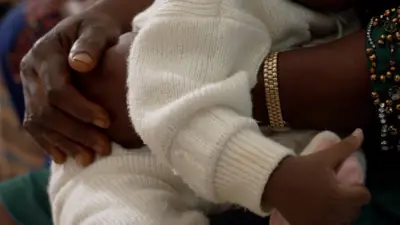We've updated our Privacy and Cookies Policy
We've made some important changes to our Privacy and Cookies Policy and we want you to know what this means for you and your data.
Giving birth two million years ago was 'relatively easy'
Image source, Getty Images
- Author, Helen Briggs
- Role, ҙуПуҙ«ГҪ News
Human childbirth can be a long, painful, drawn-out process, needing assistance and sometimes taking days.
So why do close living relatives like chimps have an easier labour, giving birth in hours and on their own?
In an attempt to answer this evolutionary question, scientists have been looking at how ancient members of the human family tree gave birth.
Human-like relatives two million years ago had it "pretty easy", according to birth reconstruction in a fossil.
For Australopithecus sediba, which lived 1.95 million years ago in South Africa, we see "a relatively easy birth process", says study researcher Dr Natalie Laudicina.
"The foetal head and shoulder breadth have ample space to pass through even the tightest dimensions of the maternal birth canal," she says.
It's a different story today, where the size and shape of the modern pelvis (a trade-off needed for walking upright), and the large size of a baby's head, make for a tight fit.
Human infants have to make several rotations through the birth canal during labour, rather than popping straight out.
By studying the few female pelvises we have of our ancient human-like relatives - only six spanning more than three million years of evolution - researchers can get an idea of what birth might have been like further back in the human family tree.
Image source, Laudicina et al, 2019
It's not the case, though, that birth became progressively more difficult during the course of human evolution.
As the University of Boston anthropologist explains, the fossil "Lucy" (Australopithecus afarensis) had a more difficult birth process than A. sediba, in terms of a tighter fit between the foetus and the birth canal, but lived about a million years earlier.
"There is a tendency to think about the evolution of human birth as a transition from an 'easy', ape-like birth to a 'difficult', modern birth," says Dr Laudicina, who reports the team's findings in the journal, .
"Instead, what we are seeing is that is not the case. "
Answering the question of when modern childbirth evolved is complicated, she says, because each fossil in the human family tree exhibited their own obstetric challenges.
And even today we see variation in how women give birth: some women have relatively easy births that take no time at all, while other women have births that last more than 20 hours with extreme pain.
Follow Helen on .
Top Stories
More to explore
Most read
Content is not available








